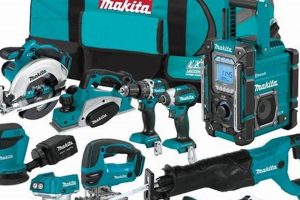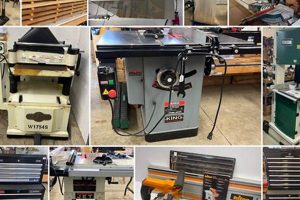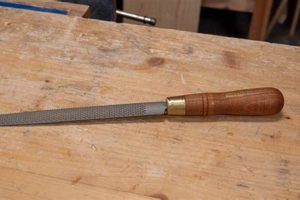The essential implements for shaping and joining wood are fundamental to the craft. These instruments, varying from hand-operated saws and chisels to power-driven routers and sanders, facilitate the transformation of raw timber into finished articles. A representative selection would include a measuring tape, hand saw, various chisels, a smoothing plane, and a mallet.
Possessing a core set of these items offers significant advantages in terms of project feasibility, precision, and efficiency. Historically, skilled artisans relied on carefully maintained tools to produce intricate and durable objects. The availability of appropriate implements allows for a broader range of projects, reduces the risk of material waste, and promotes safer working practices.
The following sections will delve into specific categories and examples of implements used in woodcraft, exploring their applications, features, and recommended models for both beginner and experienced woodworkers. This will provide a comprehensive overview of the vital equipment necessary for successful completion of many types of woodworking project.
Essential Woodworking Implements
Optimal utilization of core woodworking instruments necessitates understanding their intended purpose and employing appropriate maintenance practices to ensure longevity and performance.
Tip 1: Acquire a comprehensive measuring toolset. Precise measurements are paramount. Include a quality measuring tape, a combination square, and marking gauges to ensure accuracy in layouts and cuts.
Tip 2: Invest in high-quality hand saws. While power saws offer speed, hand saws provide control for detailed work. A dovetail saw and a crosscut saw are essential for various joinery tasks.
Tip 3: Sharpen chisels regularly. Sharp chisels are safer and more effective. A sharpening stone and honing guide should be standard shop equipment to maintain a keen edge for paring and shaping.
Tip 4: Select appropriate planes for surface preparation. Smoothing planes, block planes, and jack planes each serve distinct purposes in refining wood surfaces. Learn the function of each to achieve desired finishes.
Tip 5: Prioritize safety equipment. Safety glasses, hearing protection, and dust masks are non-negotiable. Consistent use of protective gear minimizes risks associated with woodworking.
Tip 6: Properly store and organize implements. A dedicated storage system, such as a tool cabinet or French cleat wall, prevents damage and improves workflow. Organized storage saves time and extends implement lifespan.
Tip 7: Learn basic woodworking joints. Mastery of joints such as mortise and tenon, dovetail, and rabbet enhances structural integrity and expands project possibilities. Practice these joints using off-cuts of lumber.
Effective use and meticulous upkeep of the necessary devices directly impact the quality and safety of woodworking projects. Implementing these strategies ensures optimal results.
The subsequent sections will address more specialized tools and techniques for advanced woodworking applications.
1. Precision Measurement
Accurate measurement constitutes a foundational element in successful woodworking. The capacity to precisely determine dimensions, angles, and spatial relationships directly impacts the quality of joinery, overall structural integrity, and the aesthetic outcome of any project. A deficiency in accurate measurement can lead to material waste, structural instability, and an unsatisfactory final product.
- Calibrated Rulers and Measuring Tapes
Rulers and measuring tapes, when properly calibrated, provide a direct means of determining linear dimensions. A high-quality measuring tape, for instance, ensures accurate measurements for cutting lumber to specific lengths, preventing misalignment and minimizing material waste. Inaccurate tapes can cause a domino effect of errors throughout a project.
- Squares and Combination Squares
Squares, including combination squares, verify right angles and ensure the squareness of cuts and joinery. For example, using a combination square to set up a miter saw ensures precise 45-degree cuts for picture frames or other angled assemblies. The absence of a reliable square can lead to skewed corners and a compromised overall structure.
- Marking Gauges
Marking gauges are employed to create consistent parallel lines for joinery or decorative elements. A mortise gauge, a specialized type of marking gauge, allows for precise marking of mortise and tenon joints. Using a marking gauge produces consistent joints, improves the structural integrity of the wood joint and overall project quality.
- Digital Angle Finders and Levels
Digital angle finders offer precise angular measurements, crucial for projects involving complex angles or slopes. Similarly, levels ensure horizontal and vertical alignment. These tools are essential in constructing furniture or architectural elements where adherence to specific angles and planes is critical for function and aesthetics.
The effectiveness of woodworking projects is directly proportional to the accuracy of initial measurements. Selecting and mastering appropriate measuring instruments is essential. The preceding examples illustrate the fundamental connection between instruments for precise measurement and achieving quality outcomes in shaping and combining wood.
2. Effective Cutting
Effective cutting forms a cornerstone of woodworking. The precision and efficiency with which wood is severed and shaped directly influence the final product’s quality, structural integrity, and aesthetic appeal. Appropriate implements are essential to achieving desirable results and mitigating potential hazards.
- Hand Saws: Precision and Control
Hand saws, encompassing varieties such as dovetail saws, rip saws, and crosscut saws, provide a high degree of control for intricate cuts and joinery. A dovetail saw, for instance, enables the creation of precise dovetail joints, crucial for constructing drawers and other structural elements. Inadequate saws can result in inaccurate cuts and compromised joint strength.
- Power Saws: Efficiency and Speed
Power saws, including circular saws, miter saws, and table saws, offer speed and efficiency for larger cuts and repetitive tasks. A table saw facilitates precise ripping of lumber to consistent widths, essential for building cabinets and furniture. The improper selection or maintenance of power saws can lead to inaccurate cuts and potential safety hazards.
- Specialty Saws: Task-Specific Solutions
Specialty saws, such as coping saws and fret saws, address niche cutting requirements. A coping saw enables the creation of curved profiles and intricate shapes, often employed in decorative woodworking. Neglecting specialty saws limits the range of possible design elements and project complexity.
- Sharpening Equipment: Maintaining Cutting Edge
Sharpening stones, honing guides, and sharpening jigs ensure the continuous effectiveness of cutting edges. A sharp chisel or plane, maintained with appropriate sharpening equipment, produces clean cuts and minimizes the risk of splintering. Neglecting sharpening reduces cutting efficiency and increases the effort required to shape wood.
The selection and proper utilization of implements for cutting directly influences the quality, efficiency, and safety of woodworking projects. Mastery of different types of saws and consistent maintenance of their cutting edges contributes to superior results. In contrast, improper selection, maintenance, or application of these tools can lead to poor outcomes, increased material waste, and potential injury.
3. Secure Fastening
The integrity of a woodworking project relies heavily on the robustness of its connections. Secure fastening ensures that individual components remain firmly joined, contributing to the overall durability, stability, and longevity of the finished piece. A selection of appropriate implements for secure fastening is thus vital.
- Screwdrivers and Drills: Applying Controlled Force
Screwdrivers, both manual and powered, facilitate the driving of screws into wood, creating a strong mechanical bond. Drills are frequently employed to create pilot holes, preventing wood splitting and ensuring proper screw alignment. The selection of appropriately sized and shaped screwdriver bits for various screw types is critical for secure engagement and to avoid damaging screw heads. Use of the wrong bits can easily render screw connections unusable.
- Hammers and Mallets: Impact-Driven Solutions
Hammers and mallets provide the necessary force for driving nails and other fasteners into wood. Nail guns, powered by compressed air or electricity, offer rapid and consistent nail placement for larger projects. The choice between a hammer and a mallet depends on the specific application, with mallets preferred for delicate tasks that require minimizing damage to the wood surface. Improper use of these tools can lead to bent nails or damaged surfaces.
- Clamps: Applying Sustained Pressure
Clamps exert sustained pressure on joined surfaces, ensuring a tight and consistent bond during adhesive curing. Various types of clamps, including bar clamps, pipe clamps, and spring clamps, cater to diverse project requirements. Consistent pressure is paramount to a strong bond during the adhesive set time. The absence of proper clamping can result in weak joints and potential structural failure.
- Adhesives: Chemical Bonding Agents
Wood glue, epoxy, and other adhesives create a chemical bond between wood surfaces, augmenting mechanical fasteners. The selection of an appropriate adhesive depends on the wood species, joint type, and environmental conditions. For example, water-resistant glue is crucial for outdoor applications. Applying adhesive correctly and in sufficient quantities is essential for optimal bond strength. Inadequate adhesive application can result in a diminished joint strength and potential joint failure.
Each elementdrivers, drills, hammers, mallets, clamps, and adhesives contributes to the robustness of wooden constructions. These implements directly influence the durability and aesthetic appeal of any woodworking creation. A selection of appropriate tools for secure fastening is vital.
4. Accurate Shaping
Achieving precision in woodworking necessitates the strategic application of appropriate implements. Accurate shaping, a critical component of woodworking, directly influences the aesthetic appeal, structural integrity, and functional performance of the final product. The selection of suitable instruments and the proficiency in their usage are inextricably linked to the attainment of desired outcomes. For example, crafting a Queen Anne leg demands precise curvature, achievable through a combination of templates, spokeshaves, and rasps. Any deviation from the intended shape compromises the overall design and the piece’s visual harmony.
Planes, chisels, and rasps allow for the controlled removal of material, enabling the creation of smooth surfaces, defined edges, and intricate details. The ability to accurately shape wood extends beyond purely aesthetic considerations. Correct shaping is essential for creating functional elements like drawers that slide smoothly, doors that fit snugly within their frames, and joinery that provides structural support. In building a chair, for example, each component is shaped carefully, often through the application of spokeshaves and specialized carving tools, to ensure ergonomic comfort and structural soundness.
In conclusion, the link between accurate shaping and the essential woodworking tools is direct. Mastery of specific implements facilitates the transformation of raw material into precise forms, thereby influencing the quality and functionality of finished woodworking projects. The challenges lie in selecting the right tools for a given task, mastering their use, and maintaining their sharpness to ensure consistent results. These factors directly impact the success of woodworking endeavors.
5. Safe Operation
The effective utilization of woodworking tools necessitates adherence to stringent safety protocols. The selection and appropriate application of safety equipment are intrinsically linked to the tools themselves. This consideration extends beyond mere compliance; it constitutes a fundamental aspect of responsible tool ownership and operation. For example, the operation of a table saw mandates the use of safety glasses, hearing protection, and a push stick. Failure to employ these safety measures increases the risk of eye injury, hearing damage, and severe lacerations.
Furthermore, the maintenance and adjustment of woodworking instruments directly impact the safety of their operation. A dull blade on a circular saw requires more force to cut, increasing the likelihood of kickback. Similarly, a loose guard on a jointer compromises its protective function. Regular inspection, sharpening, and calibration are crucial for maintaining equipment in a safe operating condition. Consistent adherence to safety guidelines is also crucial in preventing accidents. This includes understanding tool limitations, following manufacturer’s instructions, and maintaining a clean and organized workspace.
In summary, safe operation is not a supplementary consideration but an inseparable component of woodworking tool selection and application. Prioritizing safety minimizes the risk of accidents, promotes responsible tool usage, and contributes to a more productive and fulfilling woodworking experience. A comprehensive approach to safety, encompassing both equipment and work practices, is paramount in mitigating the inherent risks associated with woodworking.
6. Reliable Clamping
Secure and consistent application of clamping force is indispensable in woodworking. It ensures tight joints during adhesive curing, contributing significantly to the structural integrity and longevity of finished projects. Adequate clamping apparatus is integral to the assembly process.
- Joint Integrity and Stability
Clamps maintain uniform pressure across joined surfaces, facilitating optimal adhesive bonding. For instance, in assembling a tabletop, bar clamps are applied to tightly close the joints between individual boards. Insufficient clamping results in gaps, weakening the structure and potentially leading to premature failure. The relationship is central to the creation of stable and durable furniture pieces.
- Alignment and Precision
Clamping aids in maintaining accurate alignment during assembly. Corner clamps, for example, hold frame components at precise right angles while fasteners are installed. Deviations from alignment compromise the structural integrity and the aesthetic appeal of the piece. This is an important consideration for projects requiring precision.
- Preventing Warping and Distortion
Clamping can counteract the effects of wood movement and prevent warping during glue-up. When assembling a panel, applying consistent pressure across the surface minimizes the likelihood of cupping or bowing as the adhesive dries. This proactive approach contributes to the dimensional stability of the finished product.
- Diverse Clamp Types and Applications
A range of clamp types serves various woodworking needs. F-clamps provide versatility for general assembly, while pipe clamps offer extended reach for larger projects. Specialized clamps, such as band clamps and hand screw clamps, address specific joint configurations. A comprehensive clamp collection enhances the capacity to tackle diverse assembly challenges.
The ability to apply reliable clamping force is paramount to the successful construction of woodworking projects. The examples outlined underscore the necessity of selecting appropriate clamping equipment and employing proper techniques to ensure joint integrity, alignment, and dimensional stability. A collection of diverse clamps is therefore a critical component of a complete woodworking arsenal.
Frequently Asked Questions
This section addresses common inquiries concerning the instruments deemed necessary for effective woodworking. Clarification of these points aims to facilitate informed decisions regarding tool acquisition and usage.
Question 1: Why is a comprehensive set of measuring tools considered fundamental?
Precise measurements are paramount in woodworking. Inaccurate measurements compromise joint integrity, dimensional accuracy, and the overall structural soundness of the finished product. A comprehensive set ensures the ability to accurately determine dimensions, angles, and spatial relationships.
Question 2: What distinguishes a hand saw from a power saw in terms of application?
Hand saws offer greater control for intricate cuts and detailed joinery. Power saws provide speed and efficiency for larger cuts and repetitive tasks. The choice depends on the specific task requirements and the desired balance between control and speed.
Question 3: Why is sharpening equipment classified as an essential instrument?
Sharp cutting edges are crucial for clean, accurate cuts and reduced effort. Dull tools increase the risk of splintering, require greater force, and can lead to accidents. Sharpening equipment ensures that cutting tools maintain optimal performance.
Question 4: What role do clamps play in ensuring secure fastening?
Clamps apply sustained pressure to joined surfaces during adhesive curing. This consistent pressure ensures a tight and uniform bond, contributing significantly to joint strength and structural integrity. Inadequate clamping results in weak joints and potential structural failure.
Question 5: How does safe operation relate to tool selection?
Safe operation is intrinsically linked to tool selection. Choosing the appropriate tool for a specific task and adhering to safety guidelines minimizes the risk of accidents. Safe operation requires use of adequate protective gear.
Question 6: Why is a variety of clamp types recommended?
Different woodworking projects demand varying clamping requirements. A diverse clamp collection, encompassing F-clamps, pipe clamps, and specialized clamps, provides the flexibility to address diverse assembly challenges and ensure optimal joint integrity across various project types.
Understanding the rationale behind these essential items is paramount to efficient and effective woodworking practices. A well-equipped workshop, coupled with diligent adherence to safety protocols, forms the foundation for successful woodworking endeavors.
The subsequent section will explore advanced woodworking techniques and related instruments.
Woodworking Tools You Must Have
This exploration has underscored the critical role of specific implements in facilitating successful woodworking projects. Precision measurement, effective cutting, secure fastening, accurate shaping, safe operation, and reliable clamping have been identified as fundamental elements. The selection, proper application, and diligent maintenance of instruments aligned with these elements directly influence the quality, durability, and safety of woodworking endeavors.
Continued advancement within the craft hinges on a commitment to mastering these core instruments and remaining informed about evolving technologies and techniques. Investing in appropriate implements, coupled with a dedication to safety and skill development, remains a cornerstone of effective woodworking. The pursuit of excellence within the craft is inherently linked to the mastery of essential implements.







